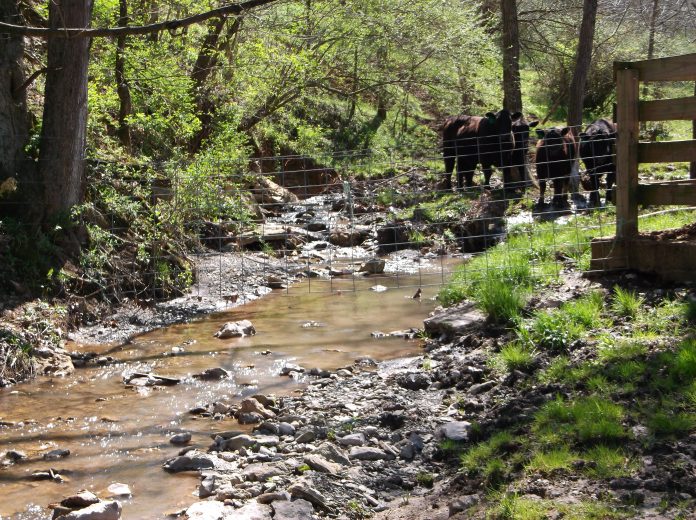Water is just one of the many assets we manage on our farms. You can travel to any state in the U.S. and dig into the local dialogue about farm management, and water management will be an issue.
Here in the eastern Midwest and Mid-Atlantic regions, we are water abundant, and our issues often center around nutrient loads in freshwater systems. Travel west and many issues become centered around water scarcity and how to manage one farm amid a whole region of farms that need to share a limited resource.
Access to water truly defines many choices on every farm. Livestock need water just the same, if not more so than you and I.
Consider this for a moment: in the heat of the summer, at 90 degrees Fahrenheit, mature cows and bulls may need 20 gallons of water per head per day. Dairy cows have the highest demand at 30 gallons of water per head per day. Horses? 12 gallons. A young 400-pound calf? 10 gallons.
Many new grazers have had to adjust plans to make sure water availability was a top priority in their new endeavor.
We are fortunate in many places to have rivers and streams moving through the valleys, and they add to the quality of our farms, homes and communities; controlling livestock access makes a difference in water quality.
Maintaining stream banks is hopefully a high priority on every farm, but this is sometimes more complicated than it sounds. In my own neighborhood, we have a ‘living river’ and multiple streams with oxbows and curves that given enough time will move their channel, particularly in high water events, which means sediment is in the water whether we mean for it be or not.
Strategies
So, what are our strategies to maintain healthy streams around livestock and farm spaces?
In one study, when given the choice, cattle drank from an off-stream water trough 92% of the time instead of drinking from a stream. This reduces stream bank erosion, concentrations of suspended solids, nitrogen, phosphorus and bacteria and returns the benefits back to the land.
Locate shade and water away from streams to improve stream bank stability and maintain riparian zone vegetation by encouraging livestock to be away from the stream. Control livestock stream crossings to discourage congregating and loafing in a stream. Streambank fencing with controlled access that includes coarse gravel in the stream crossing discourages livestock from spending time in the stream. Encourage animals to cross at these managed points.
Riparian buffer strips make an enormous difference in stream health. Sometimes, the ideal sizes are hard to achieve, but a buffer of 12 to 20 feet can make a big difference in stabilizing stream banks and filtering runoff while 30 to 60 feet is ideal with a length of 600 to 1,200 feet.
It may truly take 0.5 to 2 miles of stream length to maintain a healthy biological community and that may very well exceed your property and require a whole different level of conversation than we can fit here.
The challenge, then, is striking the right balance of keeping land in production with maintaining a riparian zone which essentially requires land to be kept out of production. Some areas have had minimal of no riparian zone for decades.
I would make the argument that long-term productivity depends on attention to stream health and maintaining it as an asset to the farm. Some kind of controlled grazing system will be necessary with an investment in maintaining fencing.
It may certainly be possible to still graze riparian spaces, with planning and proper forage selection, but allow the land to rest periodically for both short-term and long-term timelines. Locate shade, water, minerals, hay and other resources strategically away from streambanks to limit damage from high traffic.
We are fortunate in this region to have plenty of water, and it is easy to forget how much that benefits our work and the convenience it provides at home.
All of these discussions about water in agriculture will always be with us, and I don’t see that ever-changing. Hopefully, we can all take a little time to be attentive to the resources around us and provide care.
I am reminded of a litter campaign sign, “it’s just one bottle,” which encourages passersby to just be willing to pick up one or two items, as these small acts can make a difference toward greater things.
It’s a reminder to pay attention to the resources we have and be proactive about choices we can make to reap their benefits. As much as possible, treat your freshwater resources with as much care as you can give it.













